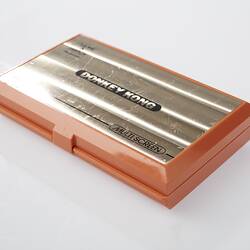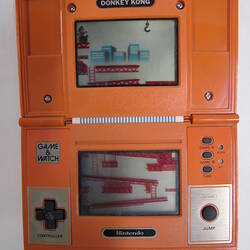Summary
Alternative Name(s): Electronic Game
Nintendo Donkey Kong game in small orange plastic game console, dated 1982. The Donkey Kong 'Game & Watch' was based on the Nintendo arcade game of the same name, released in 1981. The concept was developed by Nintendo employee Shigeru Miyamoto. The name Donkey Kong refers to a stubborn (as a donkey) primate. Donkey Kong tries to hinder the progress of 'Jumpman' up a highrise scaffold, as he tries to rescue his girlfriend.
Nintendo was founded in 1889 in Japan to make hand-made cards. After World War II it struck a deal with Disney to include Disney characters on the cards. The success of this deal provided substantial capital to the company, which expanded in a range of markets. It introduced electronic technology to the Japanese toy industry in 1970. In 1981 it released Donkey Kong, based loosely on the Nintendo arcade game of the same name also released that year. In 1989 Nintendo launched the Game Boy hand-held video game system, and in 1994 Donkey Kong was released for the Game Boy. Electronic Gaming Monthly named it Best Game Boy Game of 1994.
This example of Donkey Kong was used as a prop in the 'House Secrets' exhibition at Scienceworks, 6 March 2006 to 14 July 2013. Most of the props for the exhibition were sourced from opportunity shops in 2002 and 2003 by curator Andi Horvarth and other Museum Victoria staff. 'House Secrets' aimed to 'Explore the science behind all the familiar things in our homes', presenting 'all sorts of wonderful things we might find around the home, from the food we eat, to the appliances we use, to the animals we share our living space with.'
Physical Description
Small orange plastic game console, rectangular, hinged at centre. Flip open, clamshell design. When closed, the console has a metallic front with name and details printed; when open, the console has two screens, each with fixed graphic within which the electronic game would be played. The upper screen graphic features a series of city buildings, ladders, a person and a hook, in blue, red, brown and black. The lower screen graphic features a series of ladders with h-beams suspended beneath, in red and black. The game controls comprise a black rubber cross labelled 'CONTROLLER'; a circular rubber button labelled 'START / JUMP'; small rubber buttons labelled 'GAME A', 'GAME B' and 'TIME'; and to their right are two tiny silver buttons labelled 'ALARM' and 'ACI'. Battery cover (two button-style batteries) missing from back.
More Information
-
Collecting Areas
-
Acquisition Information
Transfer from Exhibition Collection Management (ECM), Museum Victoria, Dr Andrea Horvath - Museum Victoria, 23 Jun 2003
-
Place & Date Made
-
Inscriptions
On top: GAME & WATCH / Nintendo / DONKEY KONG / MULTISCREEN On inside: 'DONKEY KONG / GAME & WATCH / Nintendo'. [Instruction labels noted above.]
-
Classification
-
Category
-
Discipline
-
Type of item
-
Overall Dimensions - Closed
115 mm (Width), 73 mm (Depth), 23 mm (Height)
-
Overall Dimensions - Open
115 mm (Width), 143 mm (Depth), 25 mm (Height)
-
References
'History', Nintendo web site [Link 1] accessed 11 Aug 2015 'Donkey Kong (Game Boy)', Wikipedia, [Link 2](Game_Boy), accesed 11 Aug 2015 'History of Nintendo', [Link 3] accessed 11 Aug 2015
-
Keywords







